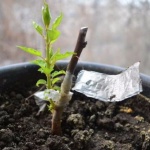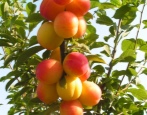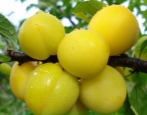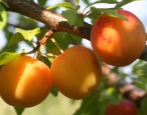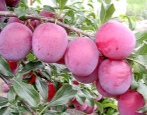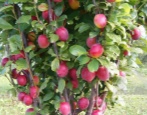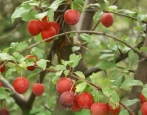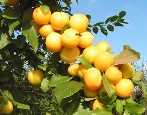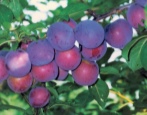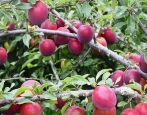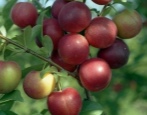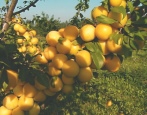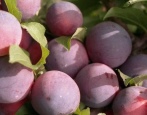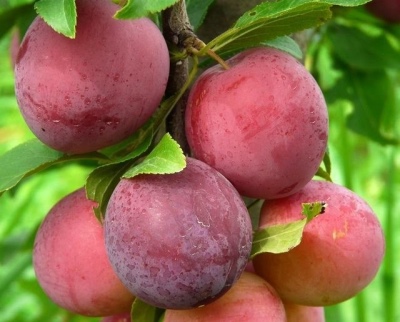
- Authors: A.V. Isachkin, N.V. Agafonov, B.N. Vorobiev, I.I. Khanzhiyan (Moscow Agricultural Academy named after K.A.Timiryazev)
- Year of approval: 2005
- Growth type: vigorous
- Ripening period: very early
- Self-fertility: self-infertile
- Fruit size: large
- Yield: medium
- Appointment: universal
- Fruit weight, g: 30
- Fruit shape: rounded, aligned
The cherry plum variety of Nesmeyan is of universal purpose, has an average yield. It started being used back in 2005. The variety belongs to very early ripening varieties.
Description of the variety
Cherry plum of Nesmeyan is considered a vigorous plant. His crown is of medium density, spreading. The shoots are of medium thickness, they are geniculate, their color is brown-green. The leaves on the plant are large enough, their shape is elliptical.
The upper side of the leaves has a glossy sheen. The underside is matt. Small denticles can be seen along the edges of the leaf plates.
Nesmeyana has good early maturity, high winter hardiness. The cultivar is self-fertile. It will require cross-pollination. Various plum varieties can act as pollinators.
Fruit characteristics
Ripe fruits are large in size. The weight of one berry is 30 grams. Their shape is symmetrical, rounded, aligned. The color is light red. The peel on fruits is of medium thickness, but at the same time quite dense.
A small seam can be seen on the surface of the ripe fruit. The funnel on the berries is rather narrow, of medium depth. The top of the cherry plum is flat.
The pulp is light red in color. It is fibrous and dense. The stone is medium in size. It can be easily separated from the pulp. The stalk is of medium thickness, it is weakly attached to the berries themselves. A light waxy coating can be seen on their surface.
Taste qualities
Cherry plum of Nesmeyan has an unusual sweet and sour taste. The tasting score reaches 4.5 points.
Ripening and fruiting
This variety begins to bear fruit in the 4th year after planting. The ripening period is very early.
Yield
Nesmeyana belongs to the varieties of average yield. There is no more specific information in official sources.
Growing and care
Planting of this culture can be performed both in spring and autumn. First you need to find the most suitable place for planting. Alycha Nesmeyan prefers well-lit areas. The more sunlight it receives, the sweeter the ripe fruits will eventually be. The best option for a crop will be neutral loamy soils. All planting holes must be prepared in advance.
Cherry plum will need periodic watering in the future. During the season, the vegetation is watered 3-4 times. Like other varieties of this culture, the Nesmeyan variety will also require the introduction of various useful dressings. Fertilizers are not required only in the first year after planting. Every year, the vegetation is fertilized with compounds that contain nitrogen. Humus, manure, potassium-phosphorus compounds are most often used as fertilizers.
Cherry plum will also need pruning. In the first 3-4 years after planting, it is necessary to form a longline crown. Further pruning will consist in thinning the green mass.
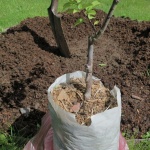
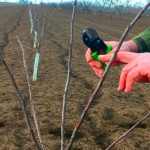
Disease and pest resistance
It should be noted that Nesmeyan's cherry plum is relatively resistant to diseases, therefore, it is recommended to periodically carry out preventive treatment of trees. It is best to do them in April.
Sometimes the culture can be affected by powdery mildew, gray mold, leaf rust. In addition, various harmful insects, including the moth, bark beetle, silkworm, and sapwood, can cause significant damage to vegetation.
To protect cherry plum from diseases and pests, all preventive mandatory measures should be taken in early spring. The trunk and skeletal branches are treated with a solution of lime.
Before bud break, you can spray the vegetation with a solution of copper or iron sulfate, or Bordeaux liquid. Under the crown, it is better to do the treatment with a urea solution (7%).
As a preventive measure, it is also recommended to use special biological fungicides and insecticides. They can be purchased ready-made in specialized stores. Preparations are diluted according to the instructions and sprayed with a ready-made liquid composition.
It should be remembered that biological preparations will work only at temperatures not lower than + 17 ... 18 degrees Celsius. Some gardeners prepare homemade medicinal tinctures. Useful herbs (dandelion, calendula, nettle, plantain), onion husks, chopped garlic, soap (household or tar) are taken as a basis.

